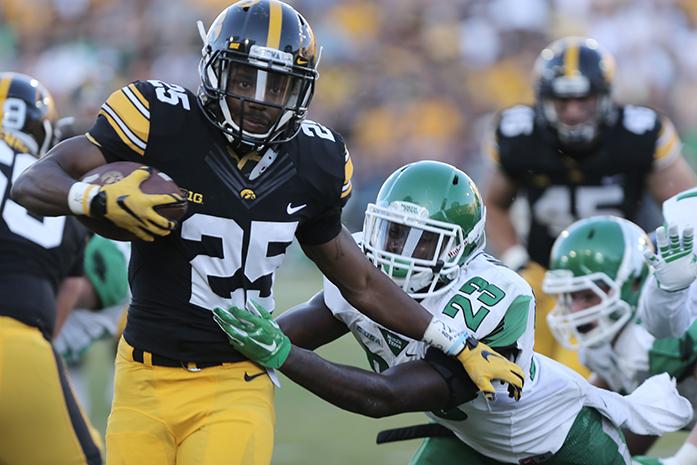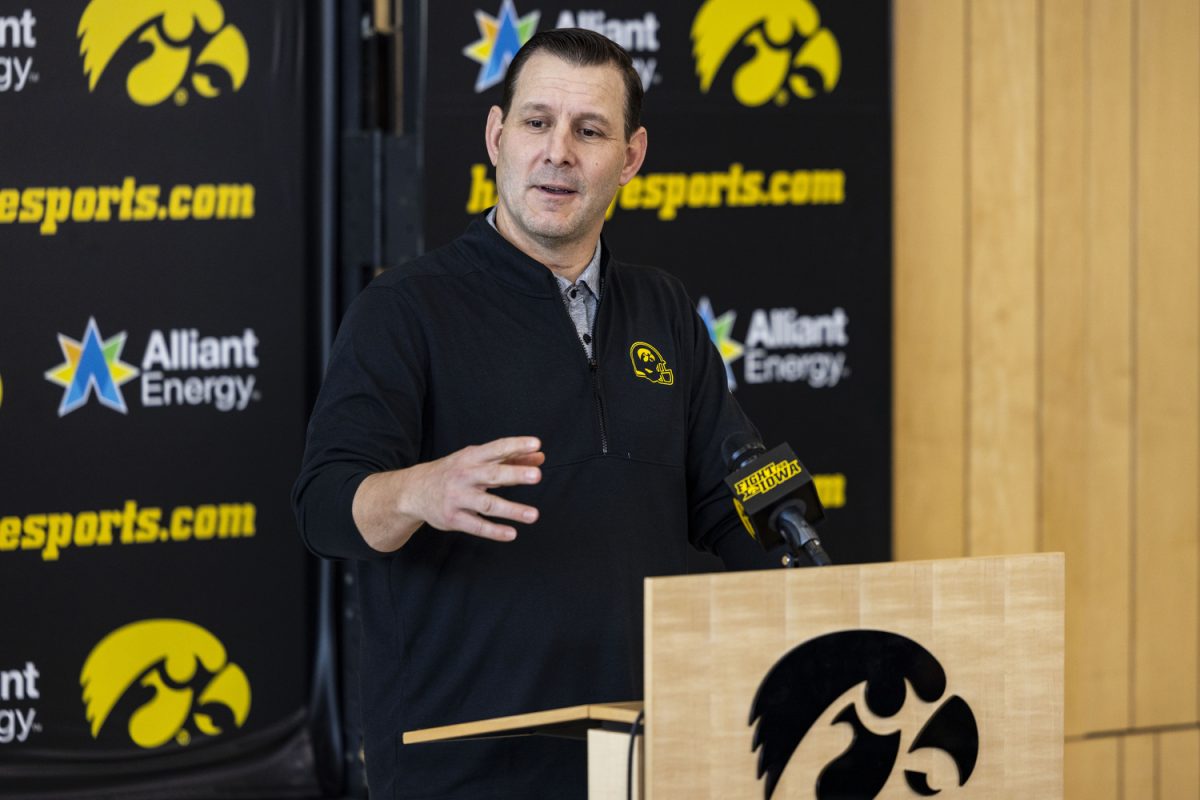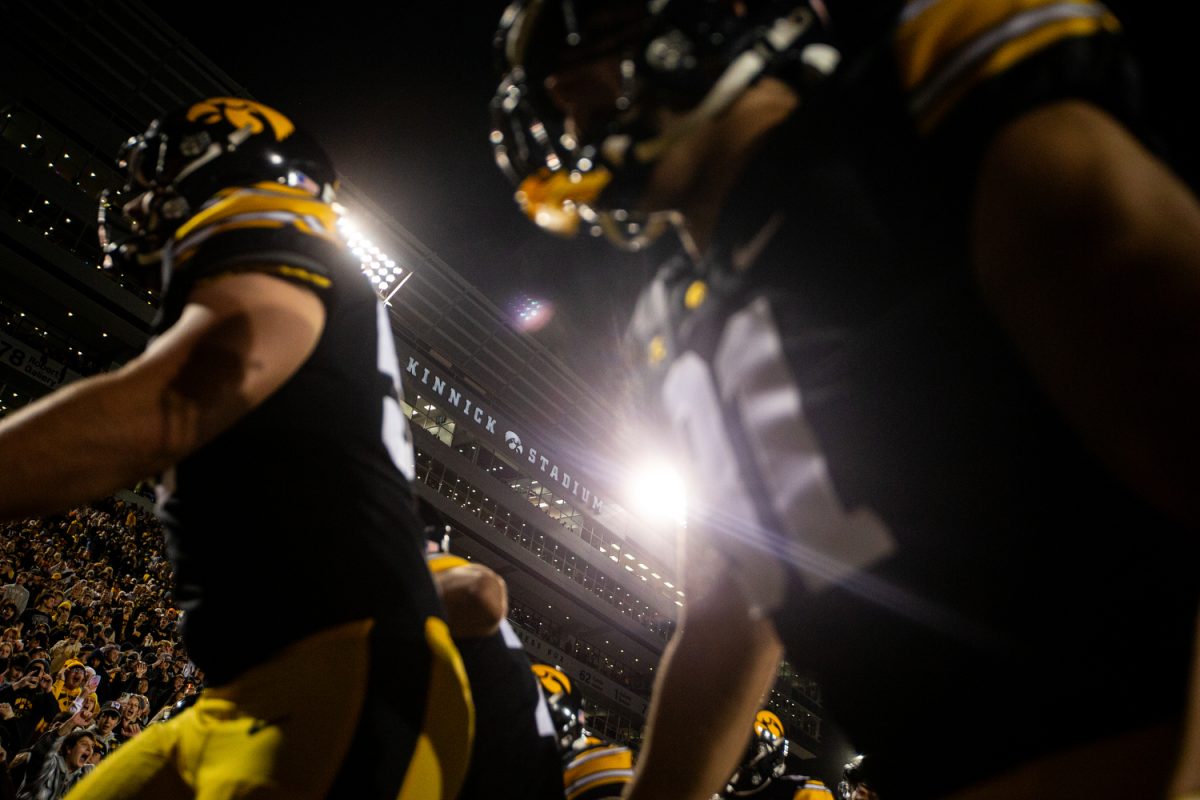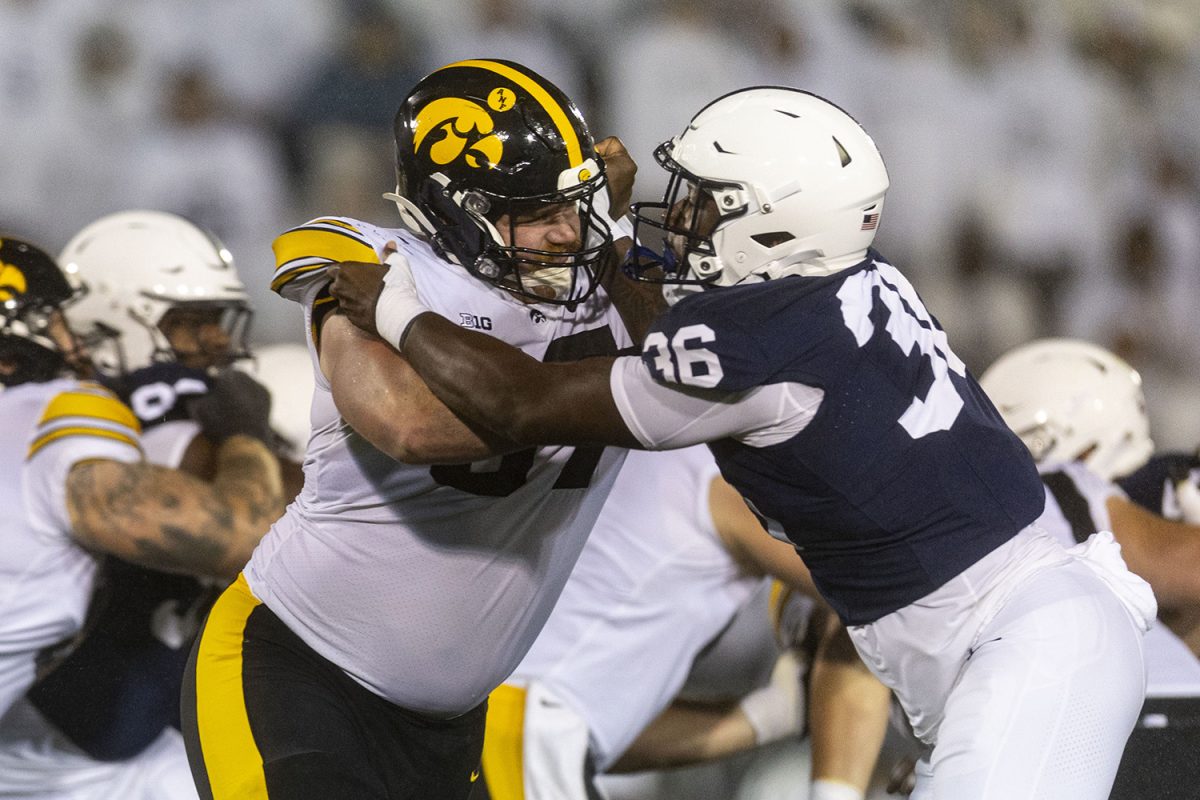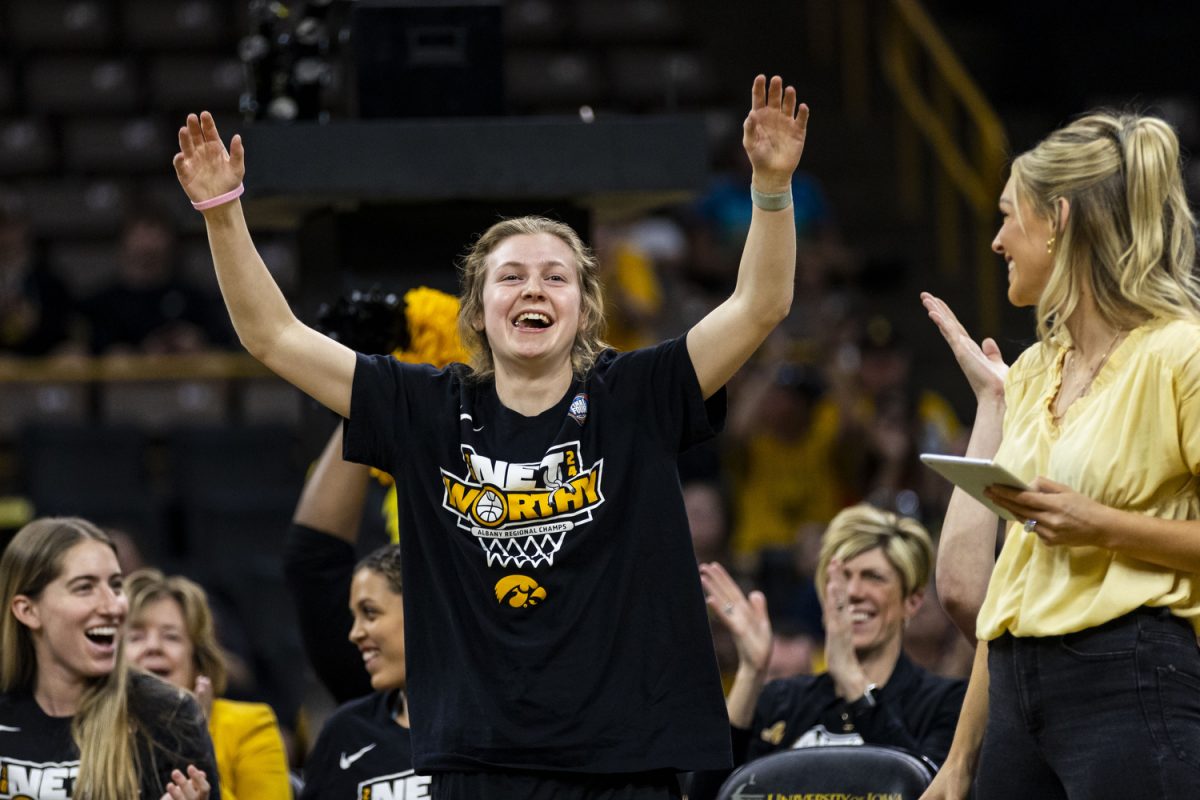By Courtney Baumann
[email protected]
Strength of schedule is a murky way to measure success. It’s a lot of numbers, and to be completely honest, pretty confusing.
As the College Football Playoff Executive Director Bill Hancock said, “It’s more of an art than a science.”
The formula for strength of schedule takes into account opponents’ winning percentages and opponents’ opponents’ winning percentages. Multiply some things by two, divide some things by three, and somehow the magical strength of schedule number appears.
There are other, simpler ways to do it, too. One list uses opponents’ combined records from the previous years for its rankings.
No matter how you measure it, though, Iowa doesn’t stand out in any lists — neither does North Dakota State, because the Bisons are not in the Football Bowl Subdivision. Although it might be a tough game, there is little to no importance of it when it comes to the bigger picture of the College Football Playoff.
The Football Bowl Subdivision ranks the Hawkeyes’ strength of schedule as 71st overall out of 128 such teams. It ranks Iowa 10th in the Big Ten.
On TeamRankings, Iowa sits 113th.
Yet, the team and head coach Kirk Ferentz continually say, “There are no easy wins.”
While that may be the case, scheduling average-at-best teams could hurt the Hawkeyes more than it helps.
According to the College Football Playoff Selection Committee’s selection process, strength of schedule is one of the largest factors when it comes to choosing which four teams will be a part of the playoffs.
It sits just behind conference championships won during the selection process — which is the first thing the committee takes into consideration — and ahead of head-to-head competition, comparative outcomes with common opponents, and other relevant factors such as key injuries that could have affected how a team performed throughout the season.
Looking back to the teams that participated in the 2016 College Football Playoffs, all but one had at least one loss before the playoffs started. Clemson was the exception; the Tigers went 14-0 until the championship game, in which they lost to Alabama.
The three others — Alabama, Oklahoma, and Michigan State — all had a loss under their belts before the postseason began.
Those teams proved that there are, in fact, no “easy wins” since Michigan State’s loss came to mediocre Nebraska (6-6 during the regular season), and Oklahoma’s loss was to Texas, which went 5-7.
However, each team’s overall strength of schedule when it came to strictly wins and losses was significantly higher than the point Iowa sat last year (No. 100) and the point it sits now.
Three of those teams were in the top 25-hardest schedules of 2015. Alabama was No. 4, Michigan State was No. 9, and Clemson was 25th.
Last season, Iowa seemed to be the “whipping boy” of college football because of its schedule. Although the team went 12-0 during the regular season, the Hawkeyes continually got criticized about the undefeated record because the strength of schedule was so low.
Even in the years the Hawkeyes have not won all of their games — some years they haven’t been above .500 — their schedule has been weak.
The arguments against Iowa have merit. From 2000 to 2015, the Hawkeyes went 120-69, putting their win percentage at 63.5 percent. In nonconference games (excluding 2016), though, that number jumps all the way to 72.9 percent; Iowa has won 43 and lost just 16. Additionally, if comparing with Big Ten play, the Hawkeyes have gone 77-53, putting them at a 59.2 win percentage.
That’s a lot of numbers, but there’s other proof, too.
Historically, Iowa has not switched up its nonconference schedule all too much.
The team has faced Miami (Ohio) three times, Northern Iowa four times, Northern Illinois four times, and Ball State three times.
Since 2000, the Hawkeyes have seen seven teams from the Mid-American Conference, and a majority of their other opponents have been from Conference USA, Mississippi Valley Conference, the Sunbelt Conference, the Colonial Athletic Conference, and the Big Sky Conference.
Over the past 15 seasons, Iowa has scheduled just four opponents from power conferences, other than the annual rivalry games with Iowa State. During those years, Iowa has seen Pittsburgh four times, Arizona twice, Syracuse twice, and Arizona State twice.
During the years Iowa played those four opponents, only twice did a team have more than eight wins. Pittsburgh went 9-4 during the 2011 season, and Arizona State was 9-3 in 2004 — Iowa lost to the Sun Devils that year.
Even so, the Hawkeyes have gone 7-3 against teams from other power conferences, and in the more than half of years, that they have won: 2003, ’06, ’09, ’15, the team has been ranked in the top 25, as high as No. 9, No. 13, No. 4, and No. 3, respectively.
But, other than those 10 games Pittsburgh, Arizona, Syracuse, and Arizona State, Iowa has not seen an opponent in the ACC, the Big 12 (not including Iowa State), the Pac-12, or the SEC.
Adding a big-time, nonconference game could benefit the Hawkeyes in numerous ways, especially by boosting their strength of schedule, and it’s already been proven this season by Wisconsin.
After defeating then-No. 4 ranked LSU in the first game of the season, Wisconsin shot into to the heights of the AP Poll; the Badgers went from no ranking during the preseason to No. 10 in one week.
The Alabama game in 2014 and the LSU game in 2015 were both owned by ESPN, which decided which two teams would play in its premièr season-opener.
The second matchup between the Badgers and the Tigers was up to the Athletics Departments, and both programs believed it to be a good idea to meet up again — this time in Wisconsin’s neck of the woods. The Badgers played the first game in Houston, so for fairness, they wanted a “neutral” playing field in Wisconsin. They chose Lambeau Field.
Wisconsin Director of Athletics Communications Brian Lucas said the team felt the excitement of the matchup from the top down.
“From the Athletics Department down to the coaches and players, everyone gets excited for these games,” Lucas said. “We all look forward to it, and the fans love it. It’s a win-win for us. It just gives a better picture of who we are as a program right away.”
Since 2000, Wisconsin has seen nine teams from power conferences. The Badgers have scheduled 16 games in the nonconference season against a combination of LSU, Alabama, Arizona State, Oregon State, North Carolina, Arizona, West Virginia, and Oregon.
Wisconsin has gone 11-5 in those games, and even in the years in which it didn’t live up to expectations, the team had been ranked as high as No. 11.
Former Badger head coach Barry Alvarez is heavily involved in the College Football Playoff committee, and he has seen how strength of schedule can determine who is in and who is out.
That is why scheduling games against other power conferences in the nonconference season has been such a priority for Wisconsin, Lucas said, especially when it has become a trend in college football to open up the season with an exciting matchup.
When asked why the Hawkeyes have not gone the route of a similar Wisconsin/LSU matchup, Ferentz has remianed steadfast. He believes the Big Ten games are a challenge, and that is enough proof for him.
“We play in a really good conference. My guess is … every one of the 12 games will be challenging,” Ferentz said. “To count on games like that, that’s still iffy, if you think those are going to happen. If they happen, great … You know, we’ll get plenty of excitement all season long.”
It’s not something that only Ferentz believes. His players have bought into his philosophy as well.
One of the most common phrases among the Hawkeyes is, “We’re just worried about the next game,” whether that next game is the Big Ten Championship game against Michigan State, or a nonconference game against North Dakota State.
Both Ferentz and numerous players have said they do not see the upcoming game as one against an FCS opponent. They are preparing as if it is the beginning of Big Ten play.
Jaleel Johnson compared the Bison’s program with Iowa’s own. Josey Jewell said it is similar to Wisconsin.
Big Ten Commissioner Jim Delany has told the teams to no longer schedule future games against FCS teams starting in 2016. Since 2014, Iowa has had three games scheduled against FCS opponents. Of course, Ferentz had no part of that decision.
“They didn’t involve me in any of that level of decision-making for obvious reasons, as you can imagine,” he said. “I’m just guessing there’s good reason for the decisions we made as a conference.”
Follow @cbomb12 on Twitter for Iowa football news, analysis, and updates.




